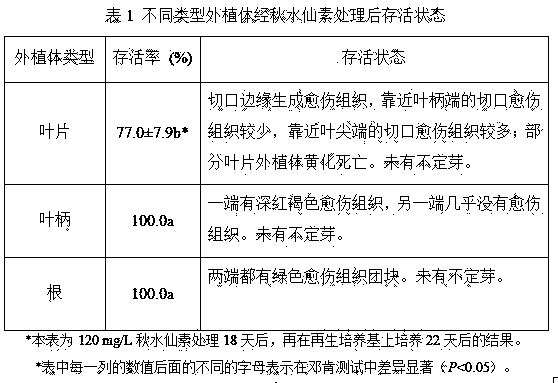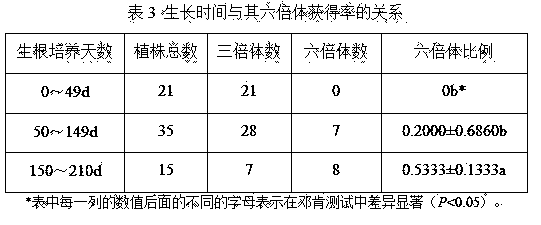Screening method for efficiently obtaining hexaploid echinacea
A screening method and technology of Echinacea, applied in the fields of crop biotechnology and genetic breeding, can solve problems such as low screening efficiency, achieve good economic and social benefits, good practical application value, and broad application prospects.
- Summary
- Abstract
- Description
- Claims
- Application Information
AI Technical Summary
Problems solved by technology
Method used
Image
Examples
Embodiment 1
[0018] Example 1 The Effect of Colchicine on the Survival Status of Different Types of Explants
[0019] The diploid seeds of Echinacea purpurea used in the present invention are purchased from the Plantation Products horticultural company of Norton, Massachusetts, U.S.; Tetraploid carries out colchicine treatment to diploid Echinacea purpurea through applicant's existing method and its chromosome doubling is obtained (Nilanthi, 2009); triploids were obtained by crossing diploids and tetraploids and cultivating seeds.
[0020] The leaves, petioles and root explants of the obtained triploid Echinacea purpurea were treated with 120 mg / L colchicine for 18 days, and then transferred to plants containing BA 0.4 mg / L, NAA 0.01 mg / L, and sucrose 30 g / L. , cultured on agar 4.5 g / L MS regeneration medium, and counted the survival rate of explants after 22 days. It can be seen from Table 1 that the culture responses of different types of triploid explants to the treatment of 120 mg / L...
Embodiment 2
[0022] Example 2 The effect of root explant selection position on induction of adventitious buds after colchicine treatment
[0023] For the same triploid line, after 30 days of rooting, select roots with similar states, and intercept different positions (near the root tip, middle, and far from the root tip). BA 0.4 mg / L, NAA 0.01 mg / L, sucrose 30 g / L, agar 4.5 g / L MS medium, at 23-27°C, cool white light intensity 600-1300 lx, photoperiod 12 h / d After culturing for 25 days under the same conditions, the adventitious buds were induced to regenerate on MS medium containing 0.5 mg / L BA, and the induction rate of adventitious buds was studied. According to Table 2, as long as the roots are rooted at the same time, and the selected roots are close to each other, no matter whether the root section close to the root tip is used as the explant or the root section far away from the root tip is used as the explant, the After the doubling of narcissine, there was no significant differ...
Embodiment 3
[0025] Example 3 The relationship between the time span from induction of adventitious bud regeneration to root tip chromosome inspection and its hexaploid acquisition rate
[0026] After the root explants treated with 120 mg / L colchicine for 18 days were transferred to MS medium containing 0.5 mg / L BA to induce adventitious shoots, record the transfer date a; when the regenerated shoots grow to When the leaves are 2 cm high, transfer them to the rooting medium (MS medium containing NAA 0.01 mg / L, sucrose 30 g / L, agar 4.5 g / L), and put them under the condition of 23-27℃, cool white light intensity 600~ Cultured under the conditions of 1300 lx and a light cycle of 12 h / d to induce adventitious roots, when the adventitious roots grow to 2 cm, record the date b. The time span from the induction of adventitious bud regeneration to root tip chromosome inspection is the growth time, recorded as b-a days.
[0027] It can be seen from Table 3 that the results show that the growth t...
PUM
 Login to view more
Login to view more Abstract
Description
Claims
Application Information
 Login to view more
Login to view more - R&D Engineer
- R&D Manager
- IP Professional
- Industry Leading Data Capabilities
- Powerful AI technology
- Patent DNA Extraction
Browse by: Latest US Patents, China's latest patents, Technical Efficacy Thesaurus, Application Domain, Technology Topic.
© 2024 PatSnap. All rights reserved.Legal|Privacy policy|Modern Slavery Act Transparency Statement|Sitemap



